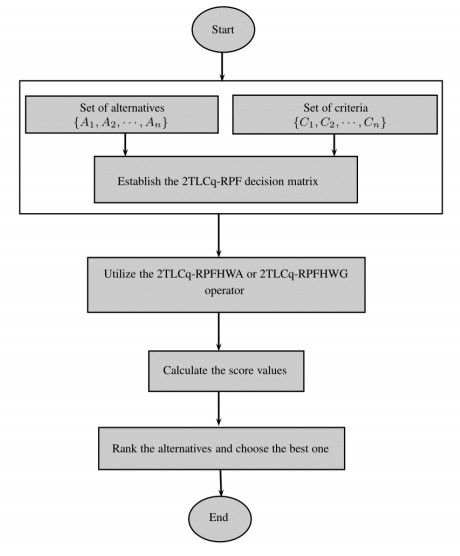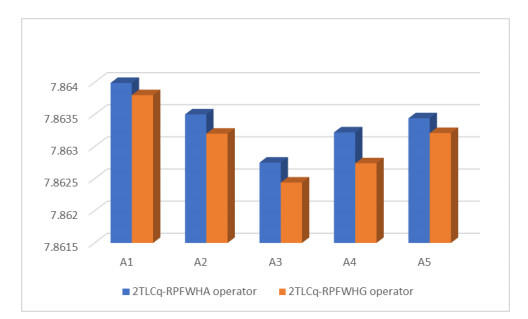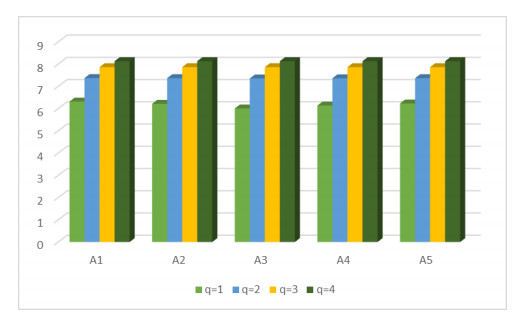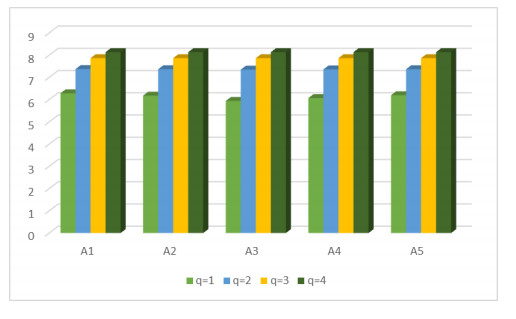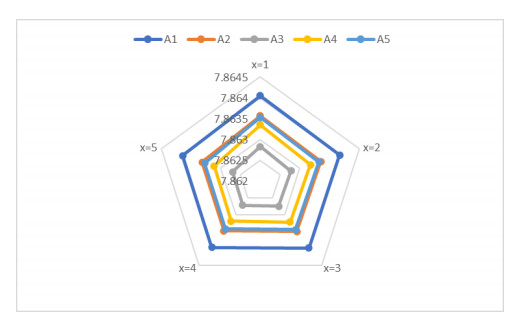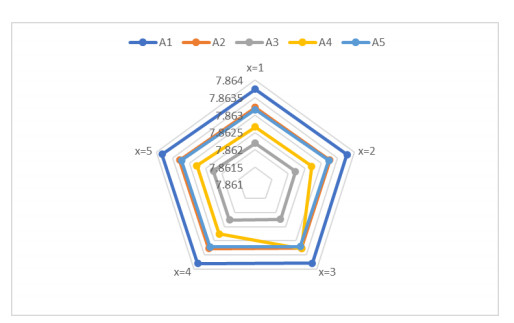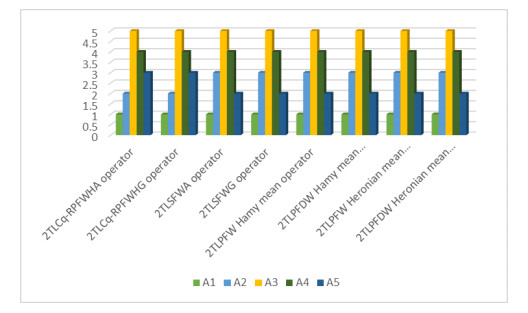1.
Introduction
Multi-attribute decision-making (MADM) is a procedure in which an alternative fulfilling all requirements is chosen from a set of available alternatives. Researchers have studied MADM problems in different areas and provided their solutions. Originally it was concerned with perfectly determined alternatives (crisp formulation) and many competing approaches have been formulated under that assumption. However, after Zadeh [1] presented the idea of a robust theory, fuzzy set (FS) theory, to tackle the vagueness and uncertainties in data during decision-making (DM). In FS theory, a membership function was formed to manage the ambiguities in data. The idea of FS is in fact the main building block as the researchers studied its features theoretically and applied it to solve MADM problems in the fuzzy framework. Researchers studied the interval-valued FSs [2,3]. Chen and Jong [4] studied the fuzzy query translation for relational database systems. Chen and Niou [5] presented fuzzy multiple-attributes group decision-making based on fuzzy preference relations. FS theory proves to be a foundational stone as it paved the way to scholars and researchers to establish many more general and remarkable extensions, such as intuitionistic fuzzy sets (IFSs) [6,7,8], Pythagorean fuzzy sets (PyFSs) [9,10], Fermatean fuzzy sets [11], hesitant fuzzy sets [12,13], and q-rung orthopair fuzzy sets (q-ROFSs) [14]. All these models consider separate a membership degree (MD) and a non-membership degree (NMD) of each object a, namely, γ(a) (MD of a) and δ(a) (NMD of a), and they respectively operate under the assumptions 0≤γ(a)+δ(a)≤1, 0≤(γ(a))2+(δ(a))2≤1, 0≤(γ(a))3+(δ(a))3≤1 and 0≤(γ(a))q+(δ(a))q≤1(q≥1).
The import of these models grew with the production of elements for analysis like aggregation operators, and decision-making applications in multiple scenarios. In view of these motivations, our main goal in this article is to present a new model (that will be abbreviated as 2TLCq-RPFS), which is designed to contain the interesting features and properties of several models beyond the fuzzy set spirit. By doing so we shall establish a broad generalization of fuzzy sets and related extensions. We shall also investigate aggregation operators and applications to group decision-making for the new model. We proceed to expand the presentation of background and explain the motivation for these targets.
A natural improvement of fuzzy sets consisted of the introduction of a neutral or abstinence degree (AD). To incorporate the idea of a distinct AD, Cuong and Kreinovich [15] presented picture fuzzy sets (PFSs) as an extended version of IFSs. In a PFS we assume that the sum of MD, NMD and AD should not exceed 1 at any object. Inspired by this idea, Li et al. [16] introduced the concept of q-rung PFS (q-RPFS), which incorporates the spirit of Yager's q-ROFS and relax the restriction to assume that the sum of qth power of MD, NMD and AD should be equal or less than 1. Akram et al. [17] studied the energy of q-ROF graphs. Khan et al. [18] studied axiomatically supported divergence measures for q-rung orthopair fuzzy sets. In DM, sometimes it becomes quite difficult to present the judgements quantitatively. To overcome this difficulty, Zadeh [19] pointed out a difference between numerical and linguistic data. He set up the notion of linguistic variables and presented the idea that qualitative information can be described by means of linguistic terms (LTs). Zhang [20] presented the concept of linguistic IFSs in which the membership functions are represented by the LTs. Garg [21] and Lin et al. [22] introduced the idea of linguistic PyFSs. Lin et al. [23] presented the idea of linguistic q-ROFS (Lq-ROFS). Akram et al. [24] provided the solution of a group DM problem based on Lq-ROF Einstein models. Herrera and Martínez [25,26] proposed a new model, namely 2-tuple linguistic representation model (2TLRM) to represent the qualitative information in MADM problems through LTs more clearly. Further research work can be studied from [27,28,29,30,31]. Notably, some researchers have presented different optimization models and applied them to solve various types of problems [32,33,34,35]. Additional algorithmic solutions and their utilizations can be studied from [36,37] among others.
The 2TLRM has become a very popular approach for researchers to deal with the MADM problems with linguistic data and gives a freedom to the experts to express their judgements qualitatively, i.e., through LTs. Aggregation operators (AOs) are indispensable tools during DM as they combine the data to produce results. More precisely, AOs play a very crucial role to transform the data in a single outcome. In the last years, researchers investigated, developed and applied many AOs in DM [38,39,40,41,42,43]. Liu et al. [44] proposed the Lq-ROF generalized point weighted AOs. Particularly inspirational operators were proposed by Hamacher [45]. The Hamacher sum and product on more generalized t-norm and t-conorm have generated extensions to many frameworks. Faizi et al. [46] proposed some Hamacher aggregation operations for intuitionistic 2-tuple linguistic sets. For further study, one may refer to [47,48,49,50,51,52]. Ju et al. [53] presented the q-ROF 2TL Muirhead mean and the dual Muirhead mean operators. Deng et al. [54,55] introduced 2-tuple linguistic Pythagorean fuzzy Hamy mean and Heronian mean AOs. Wei [56] introduced the 2TIF linguistic AOs and Lu et al. [57] presented the bipolar 2TL AOs. Zhang et al. [58] proposed a DM method using 2TLPyFSs. Recently, Akram et al. [59] presented the 2-tuple linguistic Fermatean fuzzy Hamy mean operators and Akram et al. [60] proposed a DM technique using 2TLPyFSs. However, they were not designed to cope with two-dimensional or periodic information. To handle this matter, Ramot et al. [61,62] originated the complex FS (CFS) by enlarging the range of MD of a FS, from [0,1] to the unit circle in the complex plane. Researchers have thoroughly investigated, applied and improved CFS by suitable extensions [63,64]. Rong et al. [65] presented complex q-ROF 2TL Maclaurin symmetric mean operators. The most necessary tools for their manipulation have been given, and so for example, Bi et al. [66,67] proposed geometric and arithmetic AOs in the CF environment. Liu et al. [68] presented complex q-rung orthopair fuzzy AOs. Luqman et al. [69] studied the hypergraph representations of complex fuzzy information. Naz et al. [70,71] established DM methods based on 2TL information. For some additional discussion on AOs in complex settings, the readers are referred to [72,73,74,75,76,77,78,79,80]. In this paper, we have considered a selection problem [39] which is related to choosing the best machine from a set of available machines. These machines are to be evaluated on the basis of criteria such as flexibility, reliability, etc. The following considerations have motivated us to produce this paper:
● In 2TLRM, the evaluation information is represented by a pair of elements, i.e., by (si,α), and this pair is called a 2T. In this 2T, si represents the ordinary LT from a LTS and the value α indicates the symbolic translation (ST). The 2TLRM proves to be an efficient model and a novel computational approach to represent the linguistic information. This model helps to overcome the drawbacks of the classical linguistic representation model (LRM). In addition, the 2TL model enables us to select the alternative, when different alternatives have the same LTs. These prominent features of the 2TLRM stimulated our work in a 2TL environment.
● The notion of Cq-RPFS is a generalized form of many existing extensions of fuzzy sets, thus it has enormous ability to capture quantitative uncertain information. For example, by fixing the neutral degree to zero and q to 1, the model turns into complex intuitionistic FS (CIFS). When the neutral degree is zero and q equals 2, the model becomes complex Pythagorean FS (CPyFS). And by considering all the membership degrees with q equal to 1, it changes into complex picture FS (CPFS). The 2TLCq-RPFS contains the qualities of both 2TL set and complex q-rung picture FS (Cq-RPFS), therefore, it is quite helpful to overcome complexities in data without loss of information, linguistic or otherwise.
● AOs have great importance during the DM process, as they transform a large number of values into a single value. The Hamacher AOs are a parameterized general type of AOs, which produce the averaging and Einstein operators by suitable choices of the value of a parameter. In addition, they consider the interrelationship between the input arguments. Therefore, the adaptability of the Hamacher operators is a good asset for our purposes.
To summarize, from the analysis above, we observe that there is no work on 2TLCq-RPFS in the existing literature. Apart from this, the Hamacher AOs have not been studied in the present environment. In this article, we have extended the Hamacher AOs to operate on 2TLCq-RPFSs and we have applied them for DM. We now list the major contributions of this article:
● We introduce the concept of 2TLCq-RPFS which is the generalization of 2TL term set and Cq-RPFS. Then we establish the fundamental operational laws between two 2TLCq-RPFNs. Furthermore, we present the 2TLCq-RPFWA and 2TLCq-RPFWG operators.
● We establish Hamacher laws between two 2TLCq-RPFNs. Moreover, we introduce certain AOs for the 2TLCq-RPF environment, namely, the 2TLCq-RPFHWA, 2TLCq-RPFHOWA, 2TLCq-RPFHWG and 2TLCq-RPFHOWG operators. We study their fundamental properties.
● We state a step-by-step algorithm for decision making and discuss its utilization with a case study that finds the most feasible alternative from available alternatives. Further, we perform a comparative study with some existing operators.
The remaining of the article is structured as follows: In Section 2, we recall some auxiliary notions related to the q-RPFS, Cq-RPFS, 2TL representation model and Hamacher operators. Section 3 discusses the idea of 2TL complex q-rung picture fuzzy sets along with its related ideas, operational laws, and the 2TLCq-RPFWA and 2TLCq-RPFWG operators. Section 4 introduces Hamacher operations between two 2TLCq-RPFNs and a series of AOs including the 2TLCq-RPFHWA, 2TLCq-RPFHWG, 2TLCq-RPFHOWA and 2TLCq-RPFHOWG operators, along with their fundamental properties. In Section 5, we establish a MADM strategy based on the 2TLCq-RPFHWA operator and the 2TLCq-RPFHWG operator. To demonstrate the applicability of our proposed method, we provide a numerical instance in Section 5, the influence of parameters on decision results, conducted a comparative study and discussion. Finally in Section 6, we present conclusions. The abbreviations and notations are presented in Table 1.
2.
Preliminaries
There are a considerable number of auxiliary concepts which are very important to understand the forthcoming sections. We have included some fundamental concepts for better understanding. Let us recall them before going to the next section.
Definition 2.1. [16] On a universe H, a q-RPFS ξ (with q≥1) can be defined as:
where α,β,γ:H→[0,1] denotes the MD, AD and NMD, respectively, of the element z in ξ satisfying the constraint (α(z))q+(β(z))q+(γ(z))q≤1. The degree of refusal membership of a q-RPFS is given by the formula (1−(α(z))q+(β(z))q+(γ(z))q)1q, ∀z∈H.
Definition 2.2. [73] On a universe H, a Cq-RPFS ξ (with q≥1) can be defined as:
where α,β,γ:H→[0,1] denotes the amplitude terms of MD, AD and NMD, respectively, of the element z in ξ satisfying the constraint (α(z))q+(β(z))q+(γ(z))q≤1. ζ,η,θ∈[0,2π] denotes the phase terms of MD, AD and NMD, respectively, of the element z in ξ, which satisfy the constraint (ζ(z)2π)q+(η(z)2π)q+(θ(z)2π)q≤1.
Definition 2.3. [25,26] Given a LTS ˜S={˜sk:k=0,1,2,…,Υ} having odd cardinality where Υ+1 is the cardinality of ˜S and ˜sk depicts a possible linguistic term for a LTS ˜S. Let us take an example of a LTS ˜S for Υ=5 as follows:
Following are some initial and basic operations on a LTS:
● ˜sk>˜sl, ⟺ k>l (ordering)
● max(˜sk,˜sl)=˜sk ⟺ k≥l (max operator)
● min(˜sk,˜sl)=˜sk ⟺ k≤l (min operator)
● Neg(˜sk)=˜sl such that l=Υ−k (Negative operator)
The 2TL model originated by Herrera and Martínez [25,26] is very convenient and effective for representing the qualitative evaluation information through a 2-tuple (˜sk,μk). Here, ˜sk is the ordinary LT taken from a LTS and μk is the value of ST with μk∈[−0.5,0.5).
Definition 2.4. [25,26] Given a LTS ˜S={˜sk:k=0,1,2,…,Υ} and suppose λ be the numerical value obtained after applying an aggregation operation on the indices of LTs taken from a LTS ˜S with λ∈[0,Υ]. Suppose two values k and μ, where, k=round(λ), μ=λ−k, k∈[1,Υ], and μ∈[−0.5,0.5), then μ is called ST.
The numerical value λ is converted into a 2T by means of the function Λ, and a 2T is transformed into a numerical value with the help of a function Λ−1, which are defined in the next definitions.
Definition 2.5. [25,26] Given a LTS ˜S={˜sk:k=0,1,2,…,Υ} and λ∈[0,Υ]. Then the function Λ:[0,Υ]→˜S×[−0.5,0.5) is defined as:
Definition 2.6. [25,26] Given a LTS ˜S={˜sk:k=0,1,2,…,Υ} and a 2-tuple (˜sk,μk). Then the function Λ−1:˜S×[−0.5,0.5)→[0,Υ] is defined as:
Definition 2.7. A binary function T∗:[0,1]×[0,1]→[0,1] is said to be a t-conorm if there is a t-norm T such that
for all (m,z)∈[0,1]2. Recall that a t-norm is T:[0,1]×[0,1]→[0,1] which is commutative, associative, monotonic, and for which 1 acts as an identity element.
Hamacher [45] presented the Hamacher operations, namely, the Hamacher sum and product, which are respectively defined as follows:
For x=1, these expressions return the algebraic t-norm and t-conorm.
For x=2, we get the Einstein t-norm and t-conorm.
3.
The 2-tuple linguistic complex q-rung picture fuzzy sets
This section is devoted to the novel concept of 2-tuple linguistic complex q-rung picture fuzzy set. Moreover, we establish the operational laws between two 2TLCq-RPFNs along a brief description of both the 2TLCq-RPFWA and 2TLCq-RPFWG operators.
Definition 3.1. We define a 2TLCq-RPFS L as
where (˜sα(z),A(z)), (˜sβ(z),B(z)) and (˜sγ(z),C(z)) are the amplitude terms of MD, AD and NMD, respectively. This they meet the following restrictions: ˜sα(z),˜sβ(z),˜sγ(z)∈L, A(z),B(z),C(z)∈[−0.5,0.5), 0≤Λ−1(˜sα(z),A(z))≤Υ,0≤Λ−1(˜sβ(z),B(z))≤Υ,0≤Λ−1(˜sγ(z),C(z))≤Υ and 0≤(Λ−1(˜sα(z),A(z)))q+(Λ−1(˜sβ(z),B(z)))q+(Λ−1(˜sγ(z),C(z)))q≤Υq with q≥1.
(˜sζ,D(z)), (˜sη,E(z)) and (˜sθ,F(z)) are the phase terms of MD, AD and NMD, respectively, having the restrictions ˜sζ(z),˜sη(z),˜sθ(z)∈L, D(z),E(z),F(z)∈[−0.5,0.5), 0≤Λ−1(˜sζ(z),D(z))≤Υ,0≤Λ−1(˜sη(z),E(z))≤Υ,0≤Λ−1(˜sθ(z),F(z))≤Υ and 0≤(Λ−1(˜sζ(z),D(z)))q+(Λ−1(˜sη(z),E(z)))q+(Λ−1(˜sθ(z),F(z)))q≤Υq.
Remark 3.1. For simplicity, we call L=((˜sα,A)ei2π(˜sζ,D),(˜sβ,B)ei2π(˜sη,E),(˜sγ,C)ei2π(˜sθ,F)), a 2TLq-RPFN with 0≤Λ−1(˜sα,A)≤Υ,0≤Λ−1(˜sβ,B)≤Υ,0≤Λ−1(˜sγ,C)≤Υ,0≤Λ−1(˜sζ,D)≤Υ,0≤Λ−1(˜sη,E)≤Υ,0≤Λ−1(˜sθ,F)≤Υ, 0≤(Λ−1(˜sα,A))q+(Λ−1(˜sβ,B))q+(Λ−1(˜sγ,C))q≤Υq, and 0≤(Λ−1(˜sζ,A))q+(Λ−1(˜sη,B))q+(Λ−1(˜sθ,C))q≤Υq.
Definition 3.2. Given a LTS ˜S={˜sk:k=0,1,2,…,Υ} and suppose a,b,c are the numerical values obtained after applying an aggregation operation on the indices of LTs taken from a LTS ˜S with a,b,c∈[0,Υ]. In addition, suppose there are six values α=round(a),β=round(b),γ=round(c), A=a−α,B=b−β,C=c−γ with A,B,C∈[−0.5,0.5), then A,B,C are the values of the ST for amplitude terms. Similarly, suppose d,e,f are the numerical values obtained after applying an aggregation operation on the indices of LTs taken from a LTS ˜S with d,e,f∈[0,Υ]. In addition, suppose there are six values ζ=round(d),η=round(e),θ=round(f), D=d−ζ,E=e−η,F=f−θ with D,E,F∈[−0.5,0.5), then D,E,F are the values of the ST for phase terms.
Definition 3.3. Given a LTS ˜S={˜sk:k=0,1,2,…,Υ} and a,b,c,d,e,f∈[0,Υ]. Then the function Λ:[0,Υ]→˜S×[−0.5,0.5) is defined as:
where round(.) indicates the usual round operation.
Definition 3.4. Given a LTS ˜S={˜sk:k=0,1,2,…,Υ} and a 2TLCq-RPFN
then there exists a function Λ−1:˜S×[−0.5,0.5)→[0,Υ], that restores each 2TLCq-RPFN to its equivalent numerical value a,b,c,d,e,f∈[0,Υ], where
Example 3.1. Consider a LTS ˜S={˜s0,˜s1,˜s2,˜s3,˜s4,˜s5,˜s6} with Υ=7 and a 2TLCq-RPFN
where α=3, β=1, γ=5, ζ=4, η=2, θ=4, and A=B=C=D=E=F=0. For q=3, we see that 0≤Λ−1(˜s3,0)≤7,0≤Λ−1(˜s1,0)≤7,0≤Λ−1(˜s5,0)≤7 and 0≤(Λ−1(˜s3,0))3+(Λ−1(˜s1,0))3+(Λ−1(˜s5,0))3=153<(7)3=343. Similarly, 0≤Λ−1(˜s4,0)≤7,0≤Λ−1(˜s2,0)≤7,0≤Λ−1(˜s4,0)≤7 and 0≤(Λ−1(˜s4,0))3+(Λ−1(˜s2,0))3+(Λ−1(˜s4,0))3=136<(7)3=343. Clearly, Equation (3.2) is a 2TLCq-RPFN.
3.1. The basic theory of 2TLCq-RPFSs
The next tools are designed to enable us to compare two 2TLCq-RPFNs:
Definition 3.5. Consider a 2TLCq-RPFN L=((˜sα,A)ei2π(˜sζ,D),(˜sβ,B)ei2π(˜sη,E),(˜sγ,C)ei2π(˜sθ,F)). The score function for 2TLCq-RPFNs can be defined as follows:
and the accuracy function A can be defined by the expression:
Definition 3.6. Consider two 2TLCq-RPFNs L1=((˜sα1,A1)ei2π(˜sζ1,D1),(˜sβ1,B1)ei2π(˜sη1,E1),(˜sγ1,C1)ei2π(˜sθ1,F1)) and L2=((˜sα2,A2)ei2π(˜sζ2,D2),(˜sβ2,B2)ei2π(˜sη2,E2),(˜sγ2,C2)ei2π(˜sθ2,F2)). We can compare these two 2TLCq-RPFNs by the following method:
1) If S(L1)>S(L2), then L1>L2;
2) If S(L1)=S(L2), then
● If A(L1)>A(L2), then L1>L2;
● If A(L1)=A(L2), then L1∼L2.
We next define some operational laws on 2TLCq-RPFNs:
Definition 3.7. Consider three 2TLCq-RPFNs L=((˜sα,A)ei2π(˜sζ,D),(˜sβ,B)ei2π(˜sη,E),(˜sγ,C)ei2π(˜sθ,F)), L1=((˜sα1,A1)ei2π(˜sζ1,D1), (˜sβ1,B1)ei2π(˜sη1,E1), (˜sγ1,C1)ei2π(˜sθ1,F1)) and L2=((˜sα2,A2)ei2π(˜sζ2,D2),(˜sβ2,B2)ei2π(˜sη2,E2), (˜sγ2,C2)ei2π(˜sθ2,F2)) with q≥1 and ρ>0, then
1) L1⨁L2=(Λ(Υ(1−(1−(Λ−1(˜sα1,A1)Υ)q)(1−(Λ−1(˜sα2,A2)Υ)q))1q)ei2πΛ(Υ(1−(1−(Λ−1(˜sζ1,D1)Υ)q)(1−(Λ−1(˜sζ2,D2)Υ)q))1q),Λ(Υ(Λ−1(˜sβ1,B1)Υ)(Λ−1(˜sβ2,B2)Υ))ei2πΛ(Υ(Λ−1(˜sη1,E1)Υ)(Λ−1(˜sη2,E2)Υ)),Λ(Υ(Λ−1(˜sγ1,C1)Υ)(Λ−1(˜sγ2,C2)Υ))ei2πΛ(Υ(Λ−1(˜sθ1,F1)Υ)(Λ−1(˜sθ2,F2)Υ))).
2) L1⨂L2=(Λ(Υ(Λ−1(˜sα1,A1)Υ)(Λ−1(˜sα2,A2)Υ))ei2πΛ(Υ(Λ−1(˜sζ1,D1)Υ)(Λ−1(˜sζ2,D2)Υ)),Λ(Υ(1−(1−(Λ−1(˜sβ1,B1)Υ)q)(1−(Λ−1(˜sβ2,B2)Υ)q))1q)ei2πΛ(Υ(1−(1−(Λ−1(˜sη1,E1)Υ)q)(1−(Λ−1(˜sη2,E2)Υ)q))1q),Λ(Υ(1−(1−(Λ−1(˜sγ1,C1)Υ)q)(1−(Λ−1(˜sγ2,C2)Υ)q))1q)ei2πΛ(Υ(1−(1−(Λ−1(˜sθ1,F1)Υ)q)(1−(Λ−1(˜sθ2,F2)Υ)q))1q)).
3) ρL=(Λ(Υ(1−(1−(Λ−1(˜sα,A)Υ)q)ρ)1q)ei2πΛ(Υ(1−(1−(Λ−1(˜sζ,D)Υ)q)ρ)1q),Λ(Υ(Λ−1(˜sβ,B)Υ)ρ)ei2πΛ(Υ(Λ−1(˜sη,E)Υ)ρ),Λ(Υ(Λ−1(˜sγ,C)Υ)ρ)ei2πΛ(Υ(Λ−1(˜sθ,F)Υ)ρ)).
4) Lρ=(Λ(Υ(Λ−1(˜sα,A)Υ)ρ)ei2πΛ(Υ(Λ−1(˜sζ,D)Υ)ρ),Λ(Υ(1−(1−(Λ−1(˜sβ,B)Υ)q)ρ)1q)ei2πΛ(Υ(1−(1−(Λ−1(˜sη,E)Υ)q)ρ)1q),Λ(Υ(1−(1−(Λ−1(˜sγ,C)Υ)q)ρ)1q)ei2πΛ(Υ(1−(1−(Λ−1(˜sθ,F)Υ)q)ρ)1q)).
3.2. The 2TLCq-RPFWA and 2TLCq-RPFWG operators
This subsection presents two AOs, namely, the 2TLCq-RPFWA and 2TLCq-RPFWG operators, and establish their fundamental properties.
The first operator is defined as follows:
Definition 3.8. The 2TLCq-RPFWA operator is the mapping Hn→H such that: for each collection of 2TLCq-RPFNs Lk=((˜sαk,Ak)ei2π(˜sζk,Dk),(˜sβk,Bk)ei2π(˜sηk,Ek),(˜sγk,Ck)ei2π(˜sθk,Fk)) (k=1,2,…,n),
where W=(W1,W2,…,Wn)T is the weight vector of Lk(k=1,2,…,n) with Wk∈[0,1] and n∑k=1Wk=1.
Our next result computes the expression of the 2TLCq-RPFWA operator:
Theorem 3.1. Consider a collection of 2TLCq-RPFNs Lk=((˜sαk,Ak)ei2π(˜sζk,Dk),(˜sβk, Bk)ei2π(˜sηk,Ek),(˜sγk,Ck)ei2π(˜sθk,Fk)) (k=1,2,…,n) having weight vector W=(W1,W2,…,Wn)T with Wk∈[0,1] and n∑k=1Wk=1. Then
The proof of this Theorem is given in Appendix A.
We proceed to explore the behavior of our first operator:
Proposition 3.1. Consider two collections of 2TLCq-RPFNs Lak=((˜sαak,Aak)ei2π(˜sζak,Dak), (˜sβak,Bak)ei2π(˜sηak,Eak),(˜sγak,Cak)ei2π(˜sθak,Fak)) (k=1,2,…,n) and Lbk=((˜sαbk,Abk)ei2π(˜sζbk,Dbk),(˜sβbk, Bbk)ei2π(˜sηbk,Ebk),(˜sγbk,Cbk)ei2π(˜sθbk,Fbk)) (k=1,2,…,n). Then the 2TLCq-RPFWA operator has the following properties:
1) (Idempotency) If Lk=((˜sαk,Ak)ei2π(˜sζk,Dk),(˜sβk,Bk)ei2π(˜sηk,Ek),(˜sγk,Ck)ei2π(˜sθk,Fk))=L for all (k=1,2,…,n), then
2) (Monotonicity) If Lak≤Lbk, for all (k=1,2,…,n), then
3) (Boundedness) Consider a collection of 2TLCq-RPFNs
with
and
then
The second operator is defined as follows:
Definition 3.9. The 2TLCq-RPFWG operator is the mapping Hn→H such that: for each collection of 2TLCq-RPFNs Lk=((˜sαk,Ak)ei2π(˜sζk,Dk),(˜sβk,Bk)ei2π(˜sηk,Ek),(˜sγk,Ck)ei2π(˜sθk,Fk)) (k=1,2,…,n),
where W=(W1,W2,…,Wn)T is the weight vector of Lk(k=1,2,…,n) with Wk∈[0,1] and n∑k=1Wk=1.
Our next result computes the expression of the 2TLCq-RPFWG operator:
Theorem 3.2. Consider a collection of 2TLCq-RPFNs Lk=((˜sαk,Ak)ei2π(˜sζk,Dk),(˜sβk, Bk)ei2π(˜sηk,Ek),(˜sγk,Ck)ei2π(˜sθk,Fk)) (k=1,2,…,n) having weight vector W=(W1,W2,…,Wn)T with Wk∈[0,1] and n∑k=1Wk=1. Then{
Proof. This proof is similar to the proof of Theorem 3.1.
To conclude this section, we explore the behavior of our second operator:
Proposition 3.2. Consider two collections of 2TLCq-RPFNs Lak=((˜sαak,Aak)ei2π(˜sζak,Dak), (˜sβak,Bak)ei2π(˜sηak,Eak),(˜sγak,Cak)ei2π(˜sθak,Fak)) (k=1,2,…,n) and Lbk=((˜sαbk,Abk)ei2π(˜sζbk,Dbk), (˜sβbk,Bbk)ei2π(˜sηbk,Ebk),(˜sγbk,Cbk)ei2π(˜sθbk,Fbk)) (k=1,2,…,n). Then the 2TLCq-RPFWG operator has the following properties:
1) (Idempotency) If Lk=((˜sαk,Ak)ei2π(˜sζk,Dk),(˜sβk,Bk)ei2π(˜sηk,Ek),(˜sγk,Ck)ei2π(˜sθk,Fk))=L for all (k=1,2,…,n), then
2) (Monotonicity) If Lak≤Lak, for all (k=1,2,…,n), then
3) (Boundedness) Consider a collection of 2TLCq-RPFNs
with
and
then
4.
Hamacher aggregation operators in the 2TLCq-RPF environment
In this section, we present Hamacher laws between 2TLCq-RPFNs, and also certain AOs, including the 2TLCq-RPFHWA, 2TLCq-RPFHOWA, 2TLCq-RPFHWG and 2TLCq-RPFHOWG operators with their properties.
Definition 4.1. Consider three 2TLCq-RPFNs L=((˜sα,A)ei2π(˜sζ,D), (˜sβ,B)ei2π(˜sη,E),(˜sγ,C)ei2π(˜sθ,F)) L1=((˜sα1,A1)ei2π(˜sζ1,D1),(˜sβ1, B1)ei2π(˜sη1,E1),(˜sγ1,C1)ei2π(˜sθ1,F1)) and L2=((˜sα2,A2)ei2π(˜sζ2,D2), (˜sβ2,B2)ei2π(˜sη2,E2),(˜sγ2,C2)ei2π(˜sθ2,F2)) with q≥1 and x,ρ>0.
Then the 2TLCq-RPF Hamacher operation between L1 and L2 are:
1) L1⨁L2=(Λ(Υ(q√Aq1+Aq2−Aq1Aq2−(1−x)Aq1Aq21−(1−x)Aq1Aq2))ei2πΛ(Υ(q√Xq1+Xq2−Xq1Xq2−(1−x)Xq1Xq21−(1−x)Xq1Xq2)),Λ(Υ(B1B2q√x+(1−x)(Bq1+Bq2−Bq1Bq2)))ei2πΛ(Υ(Y1Y2q√x+(1−x)(Yq1+Yq2−Yq1Yq2))),Λ(Υ(C1C2q√x+(1−x)(Cq1+Cq2−Cq1C2)q))ei2πΛ(Υ(Z1Z2q√x+(1−x)(Zq1+Zq2−Zq1Zq2)))).
2) L1⨂L2=(Λ(Υ(A1A2q√x+(1−x)(Aq1+Aq2−Aq1Aq2)))ei2πΛ(Υ(X1X2q√x+(1−x)(Xq1+Xq2−Xq1Xq2))),Λ(Υ(q√Bq1+Bq2−Bq1Bq2−(1−x)Bq1Bq21−(1−x)Bq1Bq2))ei2πΛ(Υ(q√Yq1+Yq2−Yq1Yq2−(1−x)Yq1Yq21−(1−x)Yq1Yq2)),Λ(Υ(q√Cq1+Cq2−Cq1Cq2−(1−x)Cq1Cq21−(1−x)Cq1Cq2))ei2πΛ(Υ(q√Zq1+Zq2−Zq1Zq2−(1−x)Zq1Zq21−(1−x)Zq1Zq2))).
3) ρL=(Λ(Υ(q√(1+(x−1)Aq)ρ−(1−Aq)ρ(1+(x−1)Aq)ρ+(x−1)(1−Aq)ρ))ei2πΛ(Υ(q√(1+(x−1)Xq)ρ−(1−Xq)ρ(1+(x−1)Xq)ρ+(x−1)(1−Xq)ρ)),Λ(Υ(q√xBρq√(1+(x−1)(1−Bq))ρ+(x−1)(Bq)ρ))ei2πΛ(Υ(q√xYρq√(1+(x−1)(1−Yq))ρ+(x−1)(Yq)ρ)),Λ(Υ(q√xCρq√(1+(x−1)(1−Cq))ρ+(x−1)(Cq)ρ))ei2πΛ(Υ(q√xZρq√(1+(x−1)(1−Zq))ρ+(x−1)(Zq)ρ))).
4) Lρ=(Λ(Υ(q√xAρq√(1+(x−1)(1−Aq))ρ+(x−1)(Aq)ρ))ei2πΛ(Υ(q√xXρq√(1+(x−1)(1−Xq))ρ+(x−1)(Xq)ρ)),Λ(Υ(q√(1+(x−1)Bq)ρ−(1−Bq)ρ(1+(x−1)Bq)ρ+(x−1)(1−Bq)ρ))ei2πΛ(Υ(q√(1+(x−1)Yq)ρ−(1−Yq)ρ(1+(x−1)Yq)ρ+(x−1)(1−Yq)ρ))Λ(Υ(q√(1+(x−1)Cq)ρ−(1−Cq)ρ(1+(x−1)Cq)ρ+(x−1)(1−Cq)ρ)),ei2πΛ(Υ(q√(1+(x−1)Zq)ρ−(1−Zq)ρ(1+(x−1)Zq)ρ+(x−1)(1−Zq)ρ))).}
Here, A1=Λ−1(˜sα1,A1)Υ, B1=Λ−1(˜sβ1,B1)Υ, C1=Λ−1(˜sγ1,C1)Υ, X1=Λ−1(˜sζ1,D1)Υ, Y1=Λ−1(˜sη1,E1)Υ and Z1=Λ−1(˜sθ1,F1)Υ. Similar notations are for L and L2.
Remark 4.1. For q=2, the 2TLCq-RPF Hamacher operations transform into the 2TLCSF Hamacher operations and for q=1, the 2TLCq-RPF Hamacher operations transform into the 2TLCPF Hamacher operations.
4.1. 2TLCq-RPF Hamacher averaging operators
This subsection presents two Hamacher AOs under the 2TLCq-RPF environment, namely, the 2TLCq-RPFHWA and 2TLCq-RPFHOWA operators.
Definition 4.2. The 2TLCq-RPFHWA operator is a mapping Hn→H such that: for each collection of 2TLCq-RPFNs Mk=((˜sαk,Ak)ei2π(˜sζk,Dk),(˜sβk,Bk)ei2π(˜sηk,Ek),(˜sγk,Ck)ei2π(˜sθk,Fk)) (k=1,2,…,n),
where W=(W1,W2,…,Wn)T is the weight vector of Mk (k=1,2,…,n) with Wk∈[0,1] and n∑k=1Wk=1.
We now present a compact expression for the definition above:
Theorem 4.1. Consider a collection of 2TLCq-RPFNs Mk=((˜sαk,Ak)ei2π(˜sζk,Dk),(˜sβk, Bk)ei2π(˜sηk,Ek),(˜sγk,Ck)ei2π(˜sθk,Fk)) (k=1,2,…,n) having weight vector W=(W1,W2,…,Wn)T with Wk∈[0,1] and n∑k=1Wk=1. Then
The proof of this Theorem is given in Appendix B.
We illustrate the application of this operator with a numerical example:
Example 4.1. Consider three 2TLCq-RPFNs M1={(˜s1,0)ei2π(˜s3,0),(˜s3,0)ei2π(˜s2,0), (˜s2,0)ei2π(˜s4,0)}, M2={(˜s4,0)ei2π(˜s1,0),(˜s5,0)ei2π(˜s3,0), (˜s1,0)ei2π(˜s1,0)} and M3={(˜s2,0)ei2π(˜s3,0),(˜s4,0)ei2π(˜s5,0), (˜s3,0)ei2π(˜s1,0)}. Assume that x=2, q=3, Υ=7 and W={0.4,0.3,0.3}. From Eq (4.2), we have
The next Proposition explores some properties of our 2TLCq-RPFHWA aggregation operator:
Proposition 4.1. Consider two collections of 2TLCq-RPFNs Mak=((˜sαak,Aak)ei2π(˜sζak,Dak), (˜sβak,Bak)ei2π(˜sηak,Eak),(˜sγak,Cak)ei2π(˜sθak,Fak)) (k=1,2,…,n) and Mbk=((˜sαbk,Abk)ei2π(˜sζbk,Dbk), (˜sβbk,Bbk)ei2π(˜sηbk,Ebk),(˜sγbk,Cbk)ei2π(˜sθbk,Fbk)) (k=1,2,…,n). Then the 2TLCq-RPFHWA operator has the following properties:
1) (Idempotency) If Mk=((˜sαk,Ak)ei2π(˜sζk,Dk),(˜sβk,Bk)ei2π(˜sηk,Ek),(˜sγk,Ck)ei2π(˜sθk,Fk))=M for all (k=1,2,…,n), then
Proof. Suppose Mk=((˜sαk,Ak)ei2π(˜sζk,Dk),(˜sβk,Bk)ei2π(˜sηk,Ek),(˜sγk,Ck)ei2π(˜sθk,Fk)) is a collection of 2TLCq-RPFNs such that Mk=M for all (k=1,2,…,n), Wk∈[0,1] and n∑k=1Wk=1. Moreover, Ak=Λ−1(˜sαk,Ak)Υ=A, Bk=Λ−1(˜sβk,Bk)Υ=B,Ck=Λ−1(˜sγk,Ck)Υ=C, Xk=Λ−1(˜sζk,Dk)Υ=X, Yk=Λ−1(˜sηk,Ek)Υ=Y and Zk=Λ−1(˜sθk,Fk)Υ=Z for all (k=1,2,…,n).From Eq (4.2), we get
2) (Monotonicity) If Mak≤Mbk, for all (k=1,2,…,n), then
3) (Boundedness) Consider a collection of 2TLCq-RPFNs
with
and
then
An alternative operator that is born from a different principle follows:
Definition 4.3. The 2TLCq-RPFHOWA operator is a mapping Hn→H such that: for each collection of 2TLCq-RPFNs Mk=((˜sαk,Ak)ei2π(˜sζk,Dk),(˜sβk,Bk)ei2π(˜sηk,Ek),(˜sγk,Ck)ei2π(˜sθk,Fk)) (k=1,2,…,n),
where μ(k) is such that Mμ(k−1)≥Mμ(k) for all k, W=(W1,W2,…,Wn)T is the weight vector of Mk(k=1,2,…,n) with Wk∈[0,1] and n∑k=1Wk=1.
Its compact expression is computed in our next theorem:
Theorem 4.2. Consider a collection of 2TLCq-RPFNs Mk=((˜sαk,Ak)ei2π(˜sζk,Dk),(˜sβk, Bk)ei2π(˜sηk,Ek),(˜sγk,Ck)ei2π(˜sθk,Fk)) (k=1,2,…,n) having weight vector W=(W1,W2,…,Wn)T with Wk∈[0,1] and n∑k=1Wk=1. Then
Proof. This proof is similar to the proof of Theorem 4.1.
For illustration, let us apply the formula above in a numerical case:
Example 4.2. Consider three 2TLCq-RPFNs M1={(˜s1,0)ei2π(˜s3,0),(˜s3,0)ei2π(˜s2,0),(˜s2,0)ei2π(˜s4,0)}, M2={(˜s4,0)ei2π(˜s1,0),(˜s5,0)ei2π(˜s3,0),(˜s1,0)ei2π(˜s1,0)} and M3={(˜s2,0)ei2π(˜s3,0),(˜s4,0)ei2π(˜s5,0),(˜s3,0)ei2π(˜s1,0)}. Assume that x=2, q=3, Υ=7 and W={0.4,0.3,0.3}. Now, S(M1)=2.5191, S(M2)=2.5190, S(M3)=2.5182. Therefore, S(M1)<S(M2)<S(M3). From Eq (4.7), we have
The next Proposition explores some properties of our 2TLCq-RPFHOWA aggregation operator:
Proposition 4.2. Consider two collections of 2TLCq-RPFNs Mak=((˜sαak,Aak)ei2π(˜sζak,Dak), (˜sβak,Bak)ei2π(˜sηak,Eak),(˜sγak,Cak)ei2π(˜sθak,Fak)) (k=1,2,…,n) and Mbk=((˜sαbk,Abk)ei2π(˜sζbk,Dbk), (˜sβbk,Bbk)ei2π(˜sηbk,Ebk),(˜sγbk,Cbk)ei2π(˜sθbk,Fbk)) (k=1,2,…,n).Then the 2TLCq-RPFHOWA operator has the following properties:
1) (Idempotency) If Mk=((˜sαk,Ak)ei2π(˜sζk,Dk),(˜sβk,Bk)ei2π(˜sηk,Ek),(˜sγk,Ck)ei2π(˜sθk,Fk))=M for all (k=1,2,…,n), then
2) (Monotonicity) If Mak≤Mbk, for all (k=1,2,…,n), then
3) (Boundedness) Consider a collection of 2TLCq-RPFNs
with
and
then
4.2. 2TLCq-RPF Hamacher geometric operators
This subsection presents two Hamacher AOs under the 2TLCq-RPF environment, namely, the 2TLCq-RPFHWG and 2TLCq-RPFHOWG operators.
Definition 4.4. Consider a collection of 2TLCq-RPFNs Mk=((˜sαk,Ak)ei2π(˜sζk,Dk),(˜sβk, Bk)ei2π(˜sηk,Ek),(˜sγk,Ck)ei2π(˜sθk,Fk)) (k=1,2,…,n). Then the 2TLCq-RPFHWG operator is a mapping Hn→H such that
where W=(W1,W2,…,Wn)T is the weight vector of Mk(k=1,2,…,n) with Wk∈[0,1] and n∑k=1Wk=1.
Its compact expression is computed in our next theorem:
Theorem 4.3. Consider a collection of 2TLCq-RPFNs Mk=((˜sαk,Ak)ei2π(˜sζk,Dk),(˜sβk, Bk)ei2π(˜sηk,Ek),(˜sγk,Ck)ei2π(˜sθk,Fk)) (k=1,2,…,n) having weight vector W=(W1,W2,…,Wn)T with Wk∈[0,1] and n∑k=1Wk=1. Then
The proof of this Theorem is presented in Appendix C.
A numerical example illustrates the computation of aggregate values by the 2TLCq-RPFHWG operator:
Example 4.3. Consider three 2TLCq-RPFNs M1={(˜s1,0)ei2π(˜s3,0),(˜s3,0)ei2π(˜s2,0),(˜s2,0)ei2π(˜s4,0)}, M2={(˜s4,0)ei2π(˜s1,0),(˜s5,0)ei2π(˜s3,0),(˜s1,0)ei2π(˜s1,0)} and M3={(˜s2,0)ei2π(˜s3,0),(˜s4,0)ei2π(˜s5,0), (˜s3,0)ei2π(˜s1,0)}. Assume that x=2, q=3, Υ=7 and W={0.4,0.3,0.3}.
From Eq (4.12), we have
Proposition 4.3. Consider two collections of 2TLCq-RPFNs Mak=((˜sαak,Aak)ei2π(˜sζak,Dak), (˜sβak,Bak)ei2π(˜sηak,Eak),(˜sγak,Cak)ei2π(˜sθak,Fak)) (k=1,2,…,n) and Mbk=((˜sαbk,Abk)ei2π(˜sζbk,Dbk), (˜sβbk,Bbk)ei2π(˜sηbk,Ebk),(˜sγbk,Cbk)ei2π(˜sθbk,Fbk)) (k=1,2,…,n). Then the 2TLCq-RPFHWG operator has the following properties:
1) (Idempotency) If Mk=((˜sαk,Ak)ei2π(˜sζk,Dk),(˜sβk,Bk)ei2π(˜sηk,Ek),(˜sγk,Ck)ei2π(˜sθk,Fk))=M for all (k=1,2,…,n), then
2) (Monotonicity) If Mak≤Mbk, for all (k=1,2,…,n), then
3) (Boundedness) Consider a collection of 2TLCq-RPFNs
with
and
then
An alternative operator that is born from a different principle follows:
Definition 4.5. Consider a collection of 2TLCq-RPFNs Mk=((˜sαk,Ak)ei2π(˜sζk,Dk),(˜sβk, Bk)ei2π(˜sηk,Ek),(˜sγk,Ck)ei2π(˜sθk,Fk)) (k=1,2,…,n). Then the 2TLCq-RPFHOWG operator is a mapping Hn→H such that
where μ(k) is such that Mμ(k−1)≥Mμ(k) for all k, W=(W1,W2,…,Wn)T is the weight vector of Mk(k=1,2,…,n) with Wk∈[0,1] and n∑k=1Wk=1.
Let us compute a compact expression for this operator:
Theorem 4.4. Consider a collection of 2TLCq-RPFNs Mk=((˜sαk,Ak)ei2π(˜sζk,Dk),(˜sβk, Bk)ei2π(˜sηk,Ek),(˜sγk,Ck)ei2π(˜sθk,Fk)) (k=1,2,…,n) having weight vector W=(W1,W2,…,Wn)T with Wk∈[0,1] and n∑k=1Wk=1. Then
Proof. This proof is similar to the proof of Theorem 4.1.
Example 4.4 Consider three 2TLCq-RPFNs M1={(˜s1,0)ei2π(˜s3,0),(˜s3,0)ei2π(˜s2,0),(˜s2,0)ei2π(˜s4,0)}, M2={(˜s4,0)ei2π(˜s1,0),(˜s5,0)ei2π(˜s3,0),(˜s1,0)ei2π(˜s1,0)} and M3={(˜s2,0)ei2π(˜s3,0),(˜s4,0)ei2π(˜s5,0),(˜s3,0)ei2π(˜s1,0)}. Assume that x=2, q=3, Υ=7 and W={0.4,0.3,0.3}. Now, S(M1)=2.5191, S(M2)=2.5190, S(M3)=2.5182. Therefore, S(M1)<S(M2)<S(M3). From Eq (4.17), we have
Proposition 4.4. Consider two collections of 2TLCq-RPFNs Mak=((˜sαak,Aak)ei2π(˜sζak,Dak), (˜sβak,Bak)ei2π(˜sηak,Eak),(˜sγak,Cak)ei2π(˜sθak,Fak)) (k=1,2,…,n) and Mbk=((˜sαbk,Abk)ei2π(˜sζbk,Dbk), (˜sβbk,Bbk)ei2π(˜sηbk,Ebk),(˜sγbk,Cbk)ei2π(˜sθbk,Fbk)) (k=1,2,…,n). Then the 2TLCq-RPFHOWG operator has the following properties:
1) (Idempotency) If Mk=((˜sαk,Ak)ei2π(˜sζk,Dk),(˜sβk,Bk)ei2π(˜sηk,Ek),(˜sγk,Ck)ei2π(˜sθk,Fk))=M for all (k=1,2,…,n), then
2) (Monotonicity) If Mak≤Mbk, for all (k=1,2,…,n), then
3) (Boundedness) Consider a collection of 2TLCq-RPFNs
with
and
then
5.
Application
This section is devoted to an MADM algorithm, a flow chart based on the presented operators and a case study related to the selection of a machine from different available models. Furthermore, we shall discuss the impact of the parameter x on results of case study and a comparison with the already existing AOs.
5.1. Mathematical description
Consider a set of m alternatives ˇA={ˇA1,ˇA2,…,ˇAm} with n attributes or criteria C={C1,C2,…,Cn}. Assume that W=(W1,W2,…,Wn)T are the weights of attributes having the constraints Wj∈[0,1], n∑j=1Wj=1. The numerical steps are presented in Table 2.
The flowchart of the developed model is displayed in Figure 1.
5.2. Selection of best machine: A case study
We present a case study adapted from [39] which is related to the purchase a new machine from a set of five different models \mathbb{\check{A}} = \{ \mathbb{\check{A}}_{1}, \mathbb{\check{A}}_{2}, \mathbb{\check{A}}_{3}, \mathbb{\check{A}}_{4}, \mathbb{\check{A}}_{5}\}. These five models are to be evaluated on the basis of four criteria \mathbb{C} = \{ \mathbb{C}_{1}, \mathbb{C}_{2}, \mathbb{C}_{3}, \mathbb{C}_{4}\} which are given as follows:
● \mathbb{C}_{1}: Reliability
● \mathbb{C}_{2}: Safety
● \mathbb{C}_{3}: Flexibility
● \mathbb{C}_{4}: Productivity for selecting machine.
The weight vector of the criteria is \mathcal{W} = (0.4, 0.25, 0.15, 0.2)^{T}. Consider q = 3, x = 3 and nine linguistic terms \{\tilde{s}_{1}, \tilde{s}_{2}, \tilde{s}_{3}, \tilde{s}_{4}, \tilde{s}_{5}, \tilde{s}_{6}, \tilde{s}_{7}, \tilde{s}_{8}, \tilde{s}_{9}\}. We first solve this example by utilizing the 2TLC q -RPFHWA operator. The steps of the established approach are presented as follows:
Step 1. The 2TLC q -RPF judgement matrix D of the alternatives \mathbb{\check{A}}_{m} , m = 1, 2, 3, 4, 5 , based on the criteria \mathbb{C}_{j} , j = 1, 2, 3, 4 , is presented in Table 3.
Step 2. The aggregated values (for x = 3 and q = 3 ) of the 2TLC q -RPF matrix D by utilizing 2TLC q -RPFHWA operator are presented in Table 4.
Step 3. The score values are computed by utilizing Eq (3.3) and the results along with the ranking order of alternatives which are executed in Table 5. It is easy to see that the score value of \mathbb{\check{A}}_{1} is highest, therefore its ranking order is 1. Similar interpretations can be given for all the remaining alternatives.
Step 4. From Step 3 the ranking order is given as follows:
Clearly, the alternative \mathbb{\check{A}}_{1} is the best one.
Now we utilize the 2TLC q -RPFHWG operator to solve the same example.
Step 1. The 2TLC q -RPF decision matrix D of the alternatives \mathbb{\check{A}}_{m} , m = 1, 2, 3, 4, 5 , based on the criteria \mathbb{C}_{j}, j = 1, 2, 3, 4 , is presented in Table 3.
Step 2. The aggregate values (for x = 3 and q = 3 ) of the 2TLC q -RPF matrix D by utilizing 2TLC q -RPFHWG operator are presented in Table 6.
Step 3. The score values are computed by utilizing Eq (3.3) and the results along with the ranking order of alternatives are displayed in Table 7.
Step 4. From Step 3 the ranking order is given as follows:
Clearly, \mathbb{\check{A}}_{1} is the best alternative.
Figure 2 graphically displays the decision results of alternatives based on 2TLC q -RPFHWA operator and 2TLC q -RPFHWG operator (for x = 3 and q = 3 ). From inspection of Figure 2, we can observe that the score value of alternative \mathbb{\check{A}}_{1} is the highest by using both operators, whereas the score value provided by these operators for alternative \mathbb{\check{A}}_{3} is the lowest. Let us explore the situation when we keep x = 3 and we vary q\in \{1, 2, 3, 4\} . With these figures, Table 8 presents the score values and ranking order of the alternatives when we use the 2TLC q -RPFHWA operator, and Table 9 does the same when we use the 2TLC q -RPFHWG operator. Figures 3 and 4 graphically display the comparison of the alternatives when x = 3 and q\in \{1, 2, 3, 4\} in terms of the scores and rankings provided by the respective operators.
5.3. Influence of parameter
In this subsection, we discuss the influence of the parameter on the score values and final results. The parameter x play an important role during the selection of alternatives. The experts can maximize their decision assessment space through variation of parameter x based on the 2TLC q -RPFHWA and 2TL q -RPFHWG operators. Apart from this, the effects of parameters on the decision results examine the effectiveness and validity of the developed method. We utilized five different values of the parameter x to examine its influence on decision results. The parameter x represents the optimistic attitude of the decision making expert towards their assessment information and reflects the flexibility during the aggregation process. The ranking results by utilizing 2TLC q -RPFHWA and 2TL q -RPFHWG operators are listed in Tables 10 and 11, respectively. From inspection of these tables, we observe that the ranking order of the five alternatives is the same. The graphical representation of the alternatives' results based on the 2TLC q -RPFHWA and 2TL q -RPFHWG operators (for five different values of the parameter x , and q = 3 ) is shown in Figures 5 and 6, respectively. Here it is apparent that the ranking positions of the alternatives remains the same irrespective of the values of x .
5.4. Comparative study and discussion
This section provides a comparison of the results computed from established AOs with some AOs available in the literature to demonstrate the strength and flexibility of the proposed AOs. The scores and final ranking results of alternatives are executed in Table 12. For comparison, the ranking order of the five machines using those AOs and our proposed AOs are graphically displayed in Figure 7. So this figure basically shows the ranking positions of the alternatives using different AOs. The details are summarized as follows:
● We utilize the 2TLSFWA and 2TLSFWG operators [47] by taking the phase term equal to zero. It can be easily observed that the final results produced by our AOs and the results using [47] are slightly different, however, the best alternative is the same. The proposed AOs are based on the Hamacher operator. The existing operators are based on 2TLSFSs, which is a special case of 2TLC q -RPFSs (when q = 2 and the phase term is zero). Therefore, our proposed AOs are more general and flexible to solve DM problems, and produce consistent results with existing solutions.
● We utilize the 2TLPFWHM and 2TLPFWDHM operators [55] ( x = 2 ) by considering that the abstinence and phase terms equal zero. These AOs are based on the Hamy and dual Hamy mean operators. Clearly, the results are consistent with our presented AOs too.
● We utilize the 2TLPFWHM and 2TLPFWDHM operators [54] ( \xi = 1, \psi = 2 ) by considering the abstinence term and phase terms zero. These AOs are based on the Heronian and dual Heronian mean operators. The reader can observe that the ranking results are consistent with our presented AOs too.
If we consider the overall results of five machines, there is a minor difference among the ranking results produced by our presented AOs and the results computed from existing AOs. However, the optimal alternative is the same, which gives support to the authenticity of presented approach.
The 2TL representation model has the prominent feature to choose the best alternative when several alternatives have the same LT but a different value of ST. Besides this, the 2TLC q -RPFS model generalizes many existing models base on fuzzy set theory and its extensions. Therefore, the method presented here, being based on the 2TLC q -RPF environment, has broadened the space of effective assessments for the decision makers and is more general and flexible.
The merits and superiorities of the presented methodology can be summarized as follows: 1) The main advantage of the 2TLC q -RPFS is that it can handle the decision making problems both qualitatively and quantitatively. 2) The developed 2TLC q -RPFS is a new generalization in FS theory as it enables the decision makers to describe their evaluation properly and it has a wide range of applications. 3) The 2TLC q -RPFS has the advantage of adaptability, for it embeds the 2TLC picture fuzzy sets when q = 1 and the 2TLC spherical fuzzy sets when q = 2. 4) We utilize the increasingly popular Hamacher AOs within a more generalized field, i.e, 2TLC q -RPFS. The Hamacher AOs provide more detailed aggregations than other AOs, due to their utilization of a parameter x which makes them significant tools in the presented study.
To finish this discussion, we proceed to give some highlights of different optimization models:
● In the article presented by Zhao et al. [35], an online-learning based reproduction technique is established, which employs a learning algorithm. The authors have designed a reference vector strategy. The presented strategy employs a learning-based technology to increase its generalization ability.
● In a study proposed by Pasha et al. [33], the authors have given a mathematical optimization model to determine all tactical linear shipping decisions. Moreover, a decomposition based heuristic algorithm is developed to manage large size problems.
● Dulebenets [36] has presented a novel Adaptive Polypoid Memetic Algorithm for the cross-docking trucks. The developed algorithm is evaluated against the new metaheuristics. Dulebenets et al. [32] presented the multiobjective optimization technique for emergency evacuation planning in geographical locations with vulnerable population groups.
● In a paper presented by Pasha et al. [34], the authors have proposed a model for the vehicle routing problem during supply chain management. They established a customized nature-inspired Hybrid Multi-Objective Evolutionary Algorithm to solve the vehicle routing problem.
● Rabbani et al. [37] established a Mixed-integer Linear Programming model to find the best sequence of routes for ambulances to avoid untimely medical services for patients. They divided the patients into three different groups according to their conditions and utilized the Non-dominated Sorting Genetic Algorithm Ⅱ and Multi-Objective Particular Swarm Optimization to a case study to analyze the model's performance.
6.
Conclusions
The model defined by C q -RPFS enlarges the range for the MD, NMD and AD, and enables us to represent these three degrees in polar coordinates. In this way the range of degrees is extended from the numerical interval [0, 1] to the unit disk in a complex plane. Besides this, the 2TL terms help the users to better reflect the qualitative attributes. In this article, we have achieved our goal, namely, the successful formulation of the 2TLC q -RPFS framework with fundamental tools to operate with it. The model integrates the traits of the aforementioned frameworks for the representation of uncertain knowledge.
Concerning its relationships with available models, we have noted that the 2TLC q -RPFS can be transformed into the 2TL complex picture fuzzy set and 2TL complex spherical fuzzy set when q = 1 and q = 2, respectively. Therefore, the proposed approach outperforms other generalized fuzzy models that represent linguistic information. While the 2TLC q -RPFS accommodates the characteristics of both C q -RPFS and 2TLS, it can still manage the information in MADM problems. To that purpose, we have established a number of Hamacher-inspired AOs under the 2TLC q -RPF environment. The family of new AOs includes the 2TLC q -RPFWA, 2TLC q -RPFWG, 2TLC q -RPFHWA, 2TLC q -RPFHOWA, 2TLC q -RPFHWG and 2TLC q -RPFHOWG operators. We have investigated their properties and we have also provided an example of application for each of the proposed AOs. Then we have provided a step-by-step procedure for decision making, which has been applied to a numerical instance in full detail. The presented method has the ability to assign different weights to the attributes according to the decision maker's choice. Furthermore, we have estimated the robustness of the results by taking five different values (x = 1, 2, 3, 4, 5) of the parameter x. Finally, we have conducted a comparative analysis of the presented work with previous operators. The proposed research has some limitations. 2TLC q -RPFS can deal with the information under certain conditions. It may not produce fruitful results for a large collection of attributes. In future research, we will study and investigate more AOs based on 2TLC q -RPFSs. We also aim to present different decision-making methods for 2TLC q -RPFSs.
Acknowledgments
The authors extend their appreciation to the Deanship of Scientific Research at King Khalid University for funding this work through General Research Project under grant number (R.G.P.2/48/43). Alcantud is grateful to the Junta de Castilla y León and the European Regional Development Fund (Grant CLU-2019-03) for the financial support to the Research Unit of Excellence "Economic Management for Sustainability" (GECOS).
Conflict of interest
The authors declare there is no conflict of interest.
Appendix A: Proof of Theorem 3.1
Proof. We prove Eq (3.6) using the induction method for the positive integer n. For n = 1, we have
Thus Eq (3.6) holds for n = 1. Assume that it also holds for n = m,
For n = m+1, by the induction hypothesis, we have
Hence, Equation (3.6) holds for all positive integers n\geq1.
Appendix B: Proof of Theorem 4.1
Proof. We use induction method and Definition 17 to prove this theorem. For n = 2, we have
Equation (4.2) holds for n = 2. Assume that Eq (4.2) holds for n = m.
For n = m+1 by the induction hypothesis, we have
Hence, Equation (4.2) holds for all positive integers n\geq 1.
Appendix C: Proof of Theorem 4.3
Proof. We use induction method and Definition 17 to prove this theorem. For n = 2, we have
Equation (4.12) holds for n = 2. Assume that Eq (4.12) holds for n = m , i.e.,
To prove that the formula holds for n = m+1 , by induction hypothesis we have
Hence, Equation (4.12) holds for all positive integers n\geq 1.









 DownLoad:
DownLoad:
